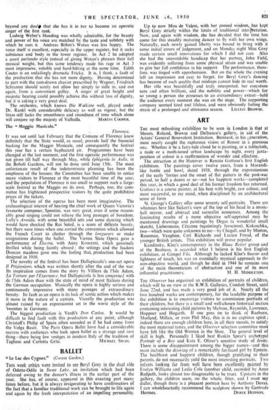ART
THE most rtfreshing exhibition to be seen in London is that at Messrs. Roland, Browse and Delbanco's gallery, in aid of the Artists' General Benevolent Institution. Bonnard, in his Leneration, most nearly caught the rapturous vision of Renoir in a previous one. Whether it be a fairy-tale cloud he is painting, or a tablecloth, a nude or a moth-toned urban landscape by night, every juxta- position of colour is a reaffirmation of wonder and affection. The attraction at the Hanover is Renato Guttuso's first English exhibition. The paintings cover twelve years, from a Morandi- like bottle and bowl, dated 1938, through the expressionism of the early 'forties and the onset of flat pattern in the post-war period, to half a dozen or so—not his happiest works—completed this year, in which a good deal of his former freedom has returned. Guttuso is a coarse painter, at his best with bright, raw colour, and most successful, to my mind, when disciplined by an architectural sense of form.
St. George's Gallery offer some seventy self-portraits. There are whimsies here like Sickert's view of the top of his head in a music- hall mirror, and abstract and surrealist nonsenses. Among the fascinating results of a more objective self-appraisal may be mentioned drawings and paintings by Degas (a wonderful small sketch), Liebermann, Cdzanne (squintingly ferocious), Kokoschka, two—which were quite unknown to me—by Chagall, and by Minton, Rosoman, Vaughan, Ceri Richards and Lucian Freud, of the younger British artists. This exhibition will prove popular.
Kandinsky, Klee's contemporary in the Blaue Reiter group and at the Bauhaus, is accorded what I believe is his first English exhibition, at Gimpel Fils. Although he lacked Klee's finesse and lightness of touch, his was an essentially mystical approach to the non-objective world, and though he died in 1944 he remains one of the main theoreticians of abstraction and one of its most




































 Previous page
Previous page